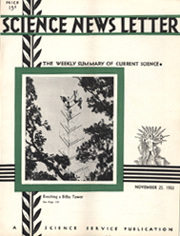From the November 25, 1933, issue

STEEL TOWERS GO UP AND DOWN TO SPEED SURVEY OF COUNTRY
Work on control surveys of the United States is being rapidly pushed forward under funds recently provided by the Public Works Administration to the U.S. Coast and Geodetic Survey. Although the immediate purpose is to provide employment to a great number of men, the present program fits into the plan to cover the country with a close network of triangulation stations so that no point will be more than 12.5 miles from a station. Boundaries of private properties and political units may then be much more certain, and much costly litigation may be avoided.
Press representatives in Washington were recently allowed a peep behind the scenes when they were invited to witness the erection of one of the triangulation towers on the campus of the University of Maryland. The tower, which is shown, in the process of erection, on the cover of this issue of Science News Letter, although approximately 100 feet high, was put up in only about three hours. It is a double structure, the outer portion, supporting the observers platform and the light, being without contact with the inner tower on which the surveying instrument is placed, so as to prevent any jarring of the instrument.
COSMIC COLLAPSES HELD CAUSE OF BIRTH OF SPIRAL NEBULAE
Worlds are, because parts of the universe collapsed. This, in a sentence shorter than a telegram, sums up a theory of the genesis of the spiral nebulae, the vast islands of suns that swim at vaster distances apart in the depths of space, as presented by the Abbé Georges Lematre of Louvain University before a Washington audience of scientists.
The Abbé Lematre, who is at present a visiting professor at the Catholic University of America, developed this theory as a part of his larger theory of an expanding universe.
The universe, the lecturer reminded his hearers, is exceedingly empty. The masses of the stars, and of their aggregations into galaxies, are impressive; but when all matter is averaged out into all the space through which it is distributed, it comes to about one atom to a cubic yard of space. How could so thin a population of particles ever become aggregated into whole whirlpools of suns?
For answer, the Abbé postulated regional irregularities in his expanding universe–regions where the rate of expansion was slowed down to a certain critical low velocity. In some of these regions, the velocity of expansion failed to accelerate again; there were “collapses,” permitting the aggregation of particles and their condensation into the spiral nebulae.
Such a moment of critically low velocity of expansion, with resultant collapse and formation of aggregates of matter, occurred for the odd millions of light-years of space with which we are familiar about a billion years ago, Abbé Lematre suggested. This billion years is much less time than is called for by the theory of the passing of all stars through the same stages of development, from giant globes of unimaginably hot gases to aged “dwarf” stars of relatively feeble temperature energy. The Abbé does not think it necessary to postulate this uniform evolutionary course for all stars; his theory admits of the simultaneous and very rapid formation of stars of all classes.
LONG-KNOWN CHEMICAL FOUND TO BE MOST VERSATILE SOLVENT
One dream of the ancient alchemists, the “universal solvent,” has been brought nearer to realization than ever before by the discovery that acetamide, a compound made from acetic acid and ammonia, has a wider range of solvent power than any other known substance. This discovery has just been announced by Prof. O.F. Stafford of the department of chemistry at the University of Oregon.
Because all life processes occur in solution, and because many important industries are dependent upon solubility relationships, Prof. Staffords discovery is regarded by his colleagues as an outstanding contribution to the science of chemistry, both in its pure and applied aspects.
The best common solvents hitherto known have been ammonia and ordinary water; acetamide is declared to be superior to both. To test his discovery, Prof. Stafford ascertained the approximate solubilities of some 400 organic and 200 inorganic substances. Working on the theory that a substance is most soluble in another substance chemically related to it, he found that acetamide has such chemical kinship to an unusually wide range of other substances. That is, each of the atom-groups in its makeup reaches out, like a hand, toward similar atom-groups in many other compounds. It is this fact that gives it its great solvent powers.







